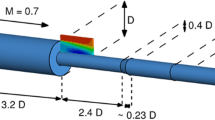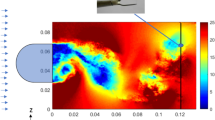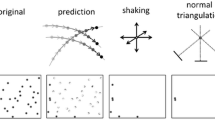Abstract
This work presents two new methods for computing finite-time Lyapunov exponents (FTLEs) from noisy spatiotemporally resolved experimentally measured image data of the type used for particle image velocimetry (PIV) or particle tracking velocimetry (PTV). These new approaches are based on the simple insight that the particle images recorded during PIV experiments represent Lagrangian flow tracers whose trajectories lend themselves to the direct computation of flow maps, and related quantities such as flow map gradients and FTLEs. We show that using this idea we can improve the reliability and accuracy of FTLE calculation through the use of either direct pathline flow map (PFM) calculation, where individual particle pathlines over a fixed period of time are used to determine the flow map, or particle tracking flow map compilation (FMC), where instantaneous tracking results are used to estimate small snapshots of the flow map which are then compiled to describe the complete flow map. Comparisons of the traditional velocity field integration (VFI) method for computing FTLE fields with these new methods show that FMC produces significantly more accurate estimates of the FTLE field for both synthetic data and experimental data especially in cases where the particle number density is low. This is because the VFI estimates particle motion while PTV directly measures particle motion and therefore generates a more accurate flow map. Overall, our results suggest that VFI is not always a reliable approach when applied to noisy experimental PIV data. For cases where particle loss between frames is minimal, the PFM can also produce better results, but the final field is susceptible to error due to the unstructured nature of the raw flow maps. When comparing the ability to match the true separatrix of a flow, FMC is shown to be a far superior method. The separatrix from FMC has an 80 % overlap with the true solution as compared to approximately 25 % for the PFM and only 1 % for the VFI method. FMC shows a significant advantage when the particle seeding is low, which is particularly relevant for applications to environmental or biological flows where adding seed particles is not always practical, and investigation of Lagrangian flow structures must rely on naturally occurring flow tracers.















Similar content being viewed by others
Notes
PRANA software is freely distributed as open source http://sourceforge.net/projects/qi-tools/.
References
Adrian RJ (1991) Particle-imaging techniques for experimental fluid-mechanics. Annu Rev Fluid Mech 23(1):261–304
Adrian RJ (2005) Twenty years of particle image velocimetry. Exp Fluids 39:159–169
Adrian R, Westerweel J (2011) Particle image velocimetry. Cambridge University Press, Cambridge
BozorgMagham AE, Ross SD et al (2013) Real-time prediction of atmospheric Lagrangian coherent structures based on forecast data: an application and error analysis. Phys D 258(1):47–60
Brady MR, Raben SG et al (2009) Methods for digital particle image sizing (DPIS): comparisons and improvements. Flow Meas Instrum 20(6):207–219
Brunton SL, Rowley CW (2010) Fast computation of finite-time Lyapunov exponent fields for unsteady flows. Chaos 20:1–12
Cardwell ND, Vlachos PP et al (2010) A multi-parametric particle pairing algorithm for particle tracking in single and multiphase flows. Meas Sci Technol 22:105406
Charonko J, Kumar R et al (2013) Vortices formed on the mitral valve tips aid normal left ventricular filling. Ann Biomed Eng 41(5):1049–1061
Du Toit PC (2010) Transport and separatrices in time dependent flows. Ph.D., California Institute of Technology
Dubuisson MP, Jain AK (1994) A modified Hausdorff distance for object matching. Pattern Recognit 1:566–568
Duncan J, Dabiri D et al (2010) Universal outlier detection for particle image velocimetry (PIV) and particle tracking velocimetry (PTV) data. Meas Sci Technol 21(5):057002
Eckstein A, Vlachos PP (2009a) Assessment of advanced windowing techniques for digital particle image velocimetry (DPIV). Meas Sci Technol 20(7):075402
Eckstein A, Vlachos PP (2009b) Digital particle image velocimetry (DPIV) robust phase correlation. Meas Sci Technol 20(5):055401
Etebari A, Vlachos PP (2005) Improvements on the accuracy of derivative estimation from DPIV velocity measurements. Exp Fluids 39(6):1040–1050
Green MA, Rowley CW et al (2011) The unsteady three-dimensional wake produced by a trapezoidal pitching panel. J Fluid Mech 685:117–145
Haller G (2001) Distinguished material surfaces and coherent structures in three-dimensional fluid flows. Phys D 149:248–277
Haller G (2002) Lagrangian coherent structures from approximate velocity data. Phys Fluids 14(6):1851–1861
Haller G (2011) A variational theory of hyperbolic Lagrangian coherent structures. Phys D 240(7):574–598
Haller G, Yuan G (2000) Lagrangian coherent structures and mixing in two-dimensional turbulence. Phys D 147:352–370
Holmes P, Lumley JL et al (1996) Turbulence, coherent structures, dynamical systems and symmetry. Cambridge University Press, Cambridge
Kahler CJ, Scharnowski S et al (2012) On the uncertainty of digital PIV and PTV near walls. Exp Fluids 52(6):1641–1656
Karri S, Charonko J et al (2009) Robust wall gradient estimation using radial basis functions and proper orthogonal decomposition (POD) for particle image velocimetry (PIV) measured fields. Meas Sci Technol 20(4):045401
Lekien F, Ross SD (2010) The computation of finite-time Lyapunov exponents on unstructured meshes and for non-Euclidean manifolds. Chaos 20(1):017505
Lipinski D, Mohseni K (2010) A ridge tracking algorithm and error estimate for efficient computation of Lagrangian coherent structures. Chaos 20(1):017504
Mathur M, Haller G et al (2007) Uncovering the Lagrangian skeleton of turbulence. Phys Rev Lett 98:1–4
Mikheev AV, Zubtsov VM (2008) Enhanced particle-tracking velocimetry (EPTV) with a combined two-component pair-matching algorithm. Meas Sci Technol 19(8):085401
Ohmi K, Li H-Y (2000) Particle-tracking velocimetry with new algorithms. Meas Sci Technol 11:603–616
Ohmi K, Panday SP (2009) Particle tracking velocimetry using the genetic algorithm. J Vis 12(3):217–232
Olcay AB, Pottebaum TS et al (2010) Sensitivity of Lagrangian coherent structure identification to flow field resolution and random errors. Chaos 20(1):017506
Peng J, Dabiri JO (2009) Transport of inertial particles by Lagrangian coherent structures: application to predator-prey interaction in jelleyfish feeding. J Fluid Mech 623:75–84
Raffel M, Willert CE et al (1998) Particle image velocimetry. Springer, Berlin
Ruiz T, Boree J et al (2010) Finite time Lagrangian analysis of an unsteady separation induced y a near wall wake. Phys Fluids 22(7):075193
Scarano F (2002) Iterative image deformation methods in PIV. Meas Sci Technol 13:R1–R19
Scarano F, Riethmuller ML (1999) Iterative multigrid approach in PIV image processing with discrete window offset. Exp Fluids 26(6):513–523
Senatore C, Ross SD (2011) Detection and characterization of transport barriers in complex flows via ridge extraction of the finite time Lyapunov exponent field. Int J Numer Methods Eng 86:116301174
Shadden SC (2011) Lagrangian coherent structures. In: Grigoriev R (ed) Transport and mixing in laminar flows: from microfluidics to oceanic currents. Wiley-VCH Verlag GmbH & Co. KGaA, Weinheim
Shadden SC, Lekien F et al (2005) Definition and properties of Lagrangian coherent structures from finite-time Lyapunov exponents in two-dimensional aperiodic flows. Phys D 212:271–304
Shadden SC, Dabiri JO et al (2006) Lagrangian analysis of fluid transport in empirical vortex ring flows. Phys Fluids 18:1–11
Shadden SC, Katija K et al (2007) Transport and stirring induced by vortex formation. J Fluid Mech 593:315–331
Shinneeb A, Balachandar R et al (2006). Quantitative investigation of coherent structures in a free jet using PIV and POD. ASME Joint US—European Fluids Engineering Summer Meeting. Miami, Fl, pp 1–8
Sirovich L (1987) Turbulence and the dynamics of coherent structures I–III. Q Appl Math 45(567–571):573–590
Solomon TH, Gollub JP (1988a) Chaotic particle-transport in time-dependent Rayleigh-Benard convection. Phys Rev A 38(12):6280–6286
Solomon TH, Gollub JP (1988b) Passive transport in steady Rayleigh-Benard convection. Phys Fluids 31(6):1372–1379
Stewart K, Niebel C et al (2012) The decay of confined vortex rings. Exp Fluids 53(1):163–171
Tallapragada P, Ross SD (2008) Particle segregation by Stokes number for small neutrally buoyant spheres in a fluid. Phys Rev E 78:1–9
Tallapragada P, Ross SD (2013) A set oriented definition of finite-time Lyapunov exponents and coherent sets. Commun Nonlinear Sci Numer Simul 18(5):1106–1126
Voth GA, Haller G et al (2002) Experimental measurements of stretching fields in fluid mixing. Phys Rev Lett 88(25)
Westerweel J, Scarano F (2005) Universal outlier detection for PIV data. Exp Fluids 39(6):1096–1100
Wilson MM, Peng J et al (2009) Lagrangian coherent structures in low Reynolds number swimming. J Phys Condens Matter 21:204105
Zhao C, Shi W et al (2005) A new Hausdorff distance for image matching. Pattern Recognit Lett 26(5):581–586
Acknowledgments
The authors would like to thank Roderick La Foy, Amir Bozorg Magham, Shibabrat Naik, and John Charonko for their helpful conversations and for commenting on the manuscript as well as Kelley Stewart and Cassie Niebel for providing the experimental data. SDR gratefully acknowledges partial support by the National Science Foundation under Grant No. CMMI-1150456. PPV gratefully acknowledges the partial support of NIH Grant 1R21HL106276-01A1.
Author information
Authors and Affiliations
Corresponding author
Rights and permissions
About this article
Cite this article
Raben, S.G., Ross, S.D. & Vlachos, P.P. Computation of finite-time Lyapunov exponents from time-resolved particle image velocimetry data. Exp Fluids 55, 1638 (2014). https://doi.org/10.1007/s00348-013-1638-8
Received:
Revised:
Accepted:
Published:
DOI: https://doi.org/10.1007/s00348-013-1638-8




